Victoria’s statue of Sir John A. Macdonald and the decision to remove it from outside City Hall are featured in a new children’s book.
The story, by First Nations child-welfare advocate Cindy Blackstock, tells the story of a family of bears visiting Victoria and learning about Macdonald’s role in creating the residential-school system as they witness the removal of his statue from City Hall. Spirit Bear: Echoes of the Past is the fourth in a series of children’s books on reconciliation.
Blackstock, a member of the Gitxsan First Nation in northern B.C., said she hopes children take from the story that learning from the past is important and that they act on what they learn.
“I am so happy just to write for kids, because I think with every generation of children comes a chance to create a society anew,” said Blackstock, who is executive director of the First Nations Child and Family Caring Society based in Ottawa and a professor of social work at McGill University.
“And one of the things I saw with the affirmation of the [residential school] survivors’ truths in Tk’emlúps and Cowessess is the shock of Canadians. I want to raise a generation of kids who aren’t shocked, that know from the earliest ages and through as they grow up, they learn more and more and are better equipped to address the injustices.”
Blackstock said she was initially working on a story about Dr. Peter Bryce, who tried to call attention to the appalling health conditions in residential schools in the early 20th century, when she visited Victoria in 2020 for a city reconciliation event focused on the Macdonald statue. At the event, she stressed the importance of remembering both the positive and negative aspects of Macdonald’s legacy. On her way home, she realized the story of the statue’s removal tied in with teaching children about Bryce.
The city removed the Macdonald statue from outside an entrance to City Hall in 2018 after hearing from representatives of the Songhees and Esquimalt nations and urban Indigenous people that its presence was painful for many. The statue is in storage, with the intention to install it in a new location with a plaque that fully describes Macdonald’s legacy.
While Blackstock’s book is aimed at five- to eight-year-olds, she said she has noticed that many adults reading it are learning the history alongside their children.
Victoria Mayor Lisa Helps read the story aloud along with Blackstock and Coun. Charlayne Thornton-Joe to a group of children attending a book launch at the Victoria Conference Centre Monday. About 65 children participated, asking questions about why the statue was removed and where it is now.
Helps said in an interview it was an honour that Blackstock chose to write about the decision to remove the Macdonald statue, “and a testimony to the way that we’re doing the work of reconciliation here in Victoria, which is deep engagement with the nations and meaningful action deemed meaningful by the nations.”
Every child received a copy of the book and a calendar that highlights important dates related to Indigenous peoples and reconciliation, and provides a monthly activity for children to act on what they learn.
On Oct. 22, the calendar prompts children to learn about Jordan’s Principle, a legal rule intended to ensure First Nations children can access the services they need without delay or disruption.
The principle is named in memory of Jordan River Anderson, a First Nations child from Norway House Cree Nation in Manitoba who died at age five in hospital, after spending more than two years waiting to leave the hospital while the provincial and federal governments argued over who should pay for his home medical care.
Children are encouraged to write a letter about why it’s important for First Nations children to access help when they need it and ask their parents to send their work to an elected official, Blackstock said. All activities are free and tie into the Truth and Reconciliation Commission’s calls to action.
The book launch is part of a three-day event in Victoria organized by the Canadian Urban Institute featuring walking tours of Victoria from a Lekwungen point of view and sessions on a variety of topics, such as missing middle housing, climate action and belonging in the city. Events run until Wednesday.
regan-elliott@timescolonist.com
You can find the calendar with monthly activities on reconciliation for children and other learning resources on the First Nations Child and Family Caring Society’s website: fncaringsociety.com/ SpiritBear/calendar.
The Canadian Urban Institute’s full program of sessions in Victoria is available here: canurb.org/cui-x-victoria



